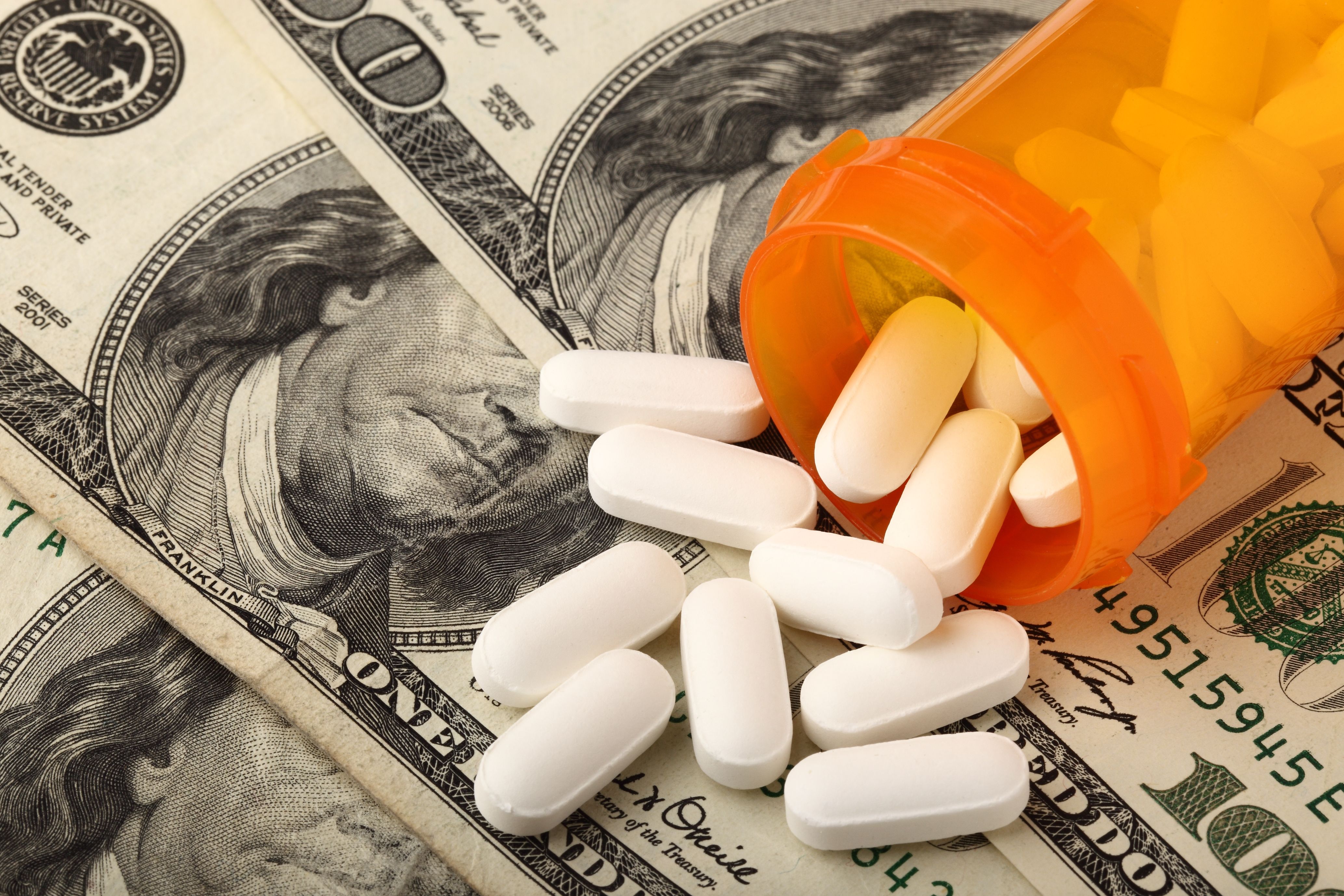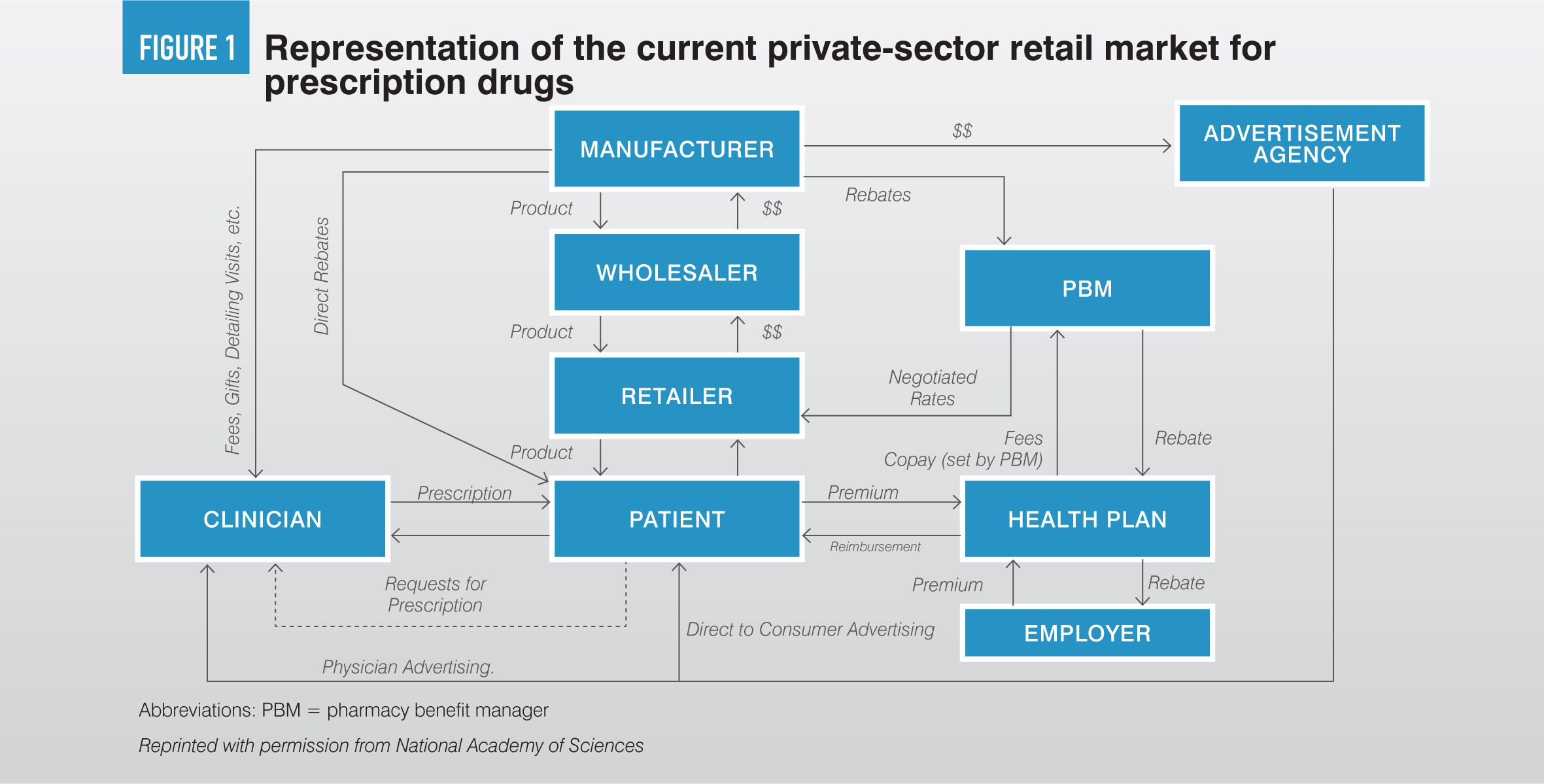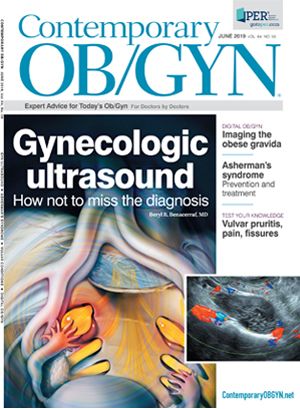Ensuring medications are more affordable without stifling innovation
The economic impact of drug costs and how we got here are examined in the first of a two-part series.
©Gang - stock.adobe.com

Dr. Lockwood

Figure 1

By now you have likely seen advertisements by the pharmaceutical industry criticizing Trump administration proposals to reduce the high cost of prescription drugs using various strategies that include linking the price that Medicare pays for drugs to that paid by other industrialized countries.1 In my own state, a modest proposal by the Governor to permit importation of Canadian medications has been met by grim commercials claiming this action would open a flood gate of deadly “contaminated” Chinese drugs. Many of these attack ads remind me of those used to try to block the Obama administration’s Affordable Care Act. When an industry attacks both liberal and conservative policy proposals aimed at restraining health care costs, it is worth carefully examining the issues.
The US pharmaceutical industry is responsible for bringing to market many truly extraordinary drugs that are revolutionizing treatment of common and rare (so-called orphan) diseases but the cost of prescription drugs is bankrupting families and threatening the solvency of both public and private health care financing systems. The first half of this two-part editorial looks at the challenges posed by the high cost of brand-name drugs and the reasons for those numbers. Part two, in a future issue, will review market-based solutions and improved regulatory policies that can make prescription drugs more affordable without stifling innovation.
In case you missed it: How likely are adolescents to fill antibiotic prescriptions for STIs?
Economic burden of high medication costs
In 2017, US health care spending was $3.5 trillion or $10,739 per person and consumed 17.9% of our Gross Domestic Product (GDP).2 That is twice as much as the average of the next nine highest-spending nations.3 To place this into context, if we could reduce health care expenditures to 10% of GDP, we would recoup enough money to pay for the country’s entire primary and secondary education system, twice our current defense budget or three times what we spend on public transportation and highways.3 Annual expenditures on pharmaceuticals now account for $500 billion or about 16.7% of total US health care spending and costs for branded drugs are increasing at an unsustainable 15% per year.3 Among the 11 highest income nations, the United States has the highest pharmaceutical spending per capita at $1443 compared with a mean of $749 for all 11 countries, with brand medications accounting for almost all our excess spending.4 In the United States, brand medications represent about 10% of prescriptions but 75% of costs.3 A recent Kaiser Foundation survey reported that 62% of respondents took at least one prescription drug and 24% took four or more.5 Of the latter, 29% had either not filled prescriptions, skipped doses or taken an over-the-counter drug instead of a prescribed one because of cost and 58% spent more than $100 per month for prescriptions. And although manufacturers of brand and generic drugs are in a high-risk business, their net profit margins are 28% and 18%, respectively, placing them second and fourth in profitability, respectively, among 26 major industrial sectors.3
Why are drug costs so high?
Normally the market for commercial products operates in a predictable manner with price reflecting supply and demand curves and intense competition enhancing the value of products. Moreover, consumers generally have access to accurate, understandable, and readily available information about product quality and price. In efficient markets, rational price equilibria are established among producers, wholesalers, retailers, and consumers. But medications are not a rational market (Figure 1). In contrast to traditional markets, in which consumers are the primary decision-makers, patients have little say over prescription drug purchases. Physicians generally determine which drugs are prescribed bound only by the occasional and appealable payor formulary. But most physicians have de minimus knowledge of what a patient will actually pay for a drug.
Next, supply chain intermediaries (i.e., wholesale and retail pharmacies, pharmacy benefit managers, and payers) engage in a complex set of opaque transactions with manufacturers and/or among themselves to set prices. Resultant rebates and discounts permit skimming of profits that together account for 41% of medication costs.3 Pharmacy benefit managers (PBMs) are supposed to negotiate prices and establish formularies to reduce costs for private insurers and self-insured large employers. But many PBMs operate their own mail-order and retail pharmacies and receive rebates from manufacturers that are not passed on to insurers, employers or patients. Worse, PBM payment algorithms are often linked to the dollar value of the drugs provided (i.e., the higher the price, the more the profit). While PBMs now cover 85% of patients with prescription drug insurance coverage, three PBMs have 73% market share, which allows them to extract greater discounts from manufacturers while retaining more of the savings.3
Direct-to-consumer (DTC) marketing also drives up the cost of brand drugs. Because of the complexity of pharmacokinetics, drug interactions, etc., most nations do not permit DTC marketing of drugs. In fact, the United States is one of only two nations in the world (New Zealand is the other) that permits DTC drug advertising.3 In 2015, $5.2 billion was spent on DTC advertising of prescription drugs, the majority on television ads and all of it tax deductible as a business expense.3 Another marketing ploy is the common use of manufacturer rebates or co-pay coupons to encourage patients to accept, request, and occasionally demand high-priced specialty drugs rather than cheaper generics. These coupons selectively increase brand drug sales by 60%.3 Pharmaceutical advertisements and drug representative “detailing” in physician offices are designed to influence physician prescribing patterns. Currently, nine out of 10 drug companies spend more on marketing than on research and development.3
Have you read - Study: 1 in 7 antibiotic scripts may be unnecessary
Also unique among other nations, US drug makers are free to set the price of their drugs without government constraints. Specialty drugs (like the ones you see commonly advertised on TV for psoriasis and Crohn’s disease) account for 2% of prescriptions but 33% of drug spending.3 Biogen’s Spinraza, an anti-sense oligonucleotide to treat spinal muscular atrophy, was initially priced at $750,000 in the first year and $375,000 annually thereafter.6 Spark Therapeutics’ Luxturna, a gene therapy for retinal disease caused by homozygosity for RPE65 gene mutations, was initially priced at $850,000 while Novartis’ Kymriah, a chimeric antigen receptor T cell (CAR T) treatment for refractory B-cell precursor acute lymphoblastic leukemia, costs $475,000.7 While it’s hard to contest the benefits of these agents if you or a family member are affected by such serious diseases, their costs appear exorbitant.
Beyond the factors itemized above, medication prices are also inflated by perverse government regulations, prohibitions against drug importation, the inability of Medicare to negotiate drug prices, brand drug makers’ suppression of generic competition, price gouging by generic drug manufacturers, and conflicts of interest accruing direct payments to physicians by industry.
Perverse effects of government regulations
The Orphan Drug Act of 1983 was designed to encourage development of treatments for rare diseases (i.e., affecting fewer than 200,000 patients/year).3 Since then, about 600 “orphan’ drugs have been approved with approvals accelerating over the past few years. Benefits to companies whose agents are approved under this pathway include an additional 7 years of exclusivity, expedited processing, reduced clinical trial size, and tax credits for development. Despite these advantages or perhaps because of them, the average orphan drug price is 5.5-fold higher than other agents and by 2020, orphan drugs will account for 21% of brand drug sales or $209 billion. Among the top 100 US drugs, orphan drug costs per year were $140,443 vs. $27,756 for non-orphan drugs.3
It is important to bear in mind that many of these orphan drugs are generics that are simply repurposed. Obstetricians will recall that in 2011, the US Food and Drug Administration (FDA) approved exclusive manufacture of 17-hydroxyprogesterone caproate by K-V Pharmaceuticals for 7 years under the Orphan Drug Act and while the compounded version cost $200 per pregnancy, the company initially priced their version at $11,000 per pregnancy.8
Yet another well-meaning but perversely applied regulation is the 2006 FDA Unapproved Drug Initiative, designed to bring grandfathered medications (i.e., those that entered the market before the FDA’s 1938 enabling legislation) in line with modern standards. Gynecologists may recall that in 2014, the FDA approved vasopressin for hypotension using this law and Par Pharmaceuticals was given exclusive rights to manufacture this 100-year-old drug. Its price quickly soared from $4 to $138 per vial, a 3,141% increase, triggering acute shortages.9 Other drugs with prices and availability similarly adversely impacted by this Act include epinephrine, ephedrine, colchicine, potassium chloride, and neostigmine. The latter an 80-year-old drug saw its price increase from $3.25 to $80.50 per vial!
Absence of regulation also poses a challenge. Other nations directly negotiate with drug makers to lower costs. In contrast, Medicare makes coverage determinations based on whether a drug is “necessary and reasonable” not on its costs for Parts A & B, which account for about 40% of Medicare drug costs. While Medicare Part D plans can negotiate prices, they use PBMs and have only 20% lower costs.3 Worse yet, because other nations aggressively negotiate drug prices, many US drug makers sell products outside this country at variable cost but charge Americans a premium to cover fixed, variable, and other costs and to generate hefty profits. Allowing drug imports would create a global market instead of compelling US consumers to subsidize other nations’ drug costs. While the Health and Human Services Secretary has had discretion to allow certain imports since 2000, this has never been done. But permitting drug imports is not a panacea because other countries might limit exports to prevent shortages and price increases. Moreover, drug makers could penalize exporting countries (e.g., in 2004, GlaxoSmithKline and Pfizer threatened to limit sales of their drugs to Canadian pharmacies that resold them in the United States).3
Suppression of generic competition and generic market distortions
The ability of generic drug manufacturers to compete with brand drug makers can have a dramatic effect on drug prices. On average, the transition to generic status reduces a drug’s cost by 70%.3 However, while generics represent 90% of prescriptions, they account for only 25% of drug costs. Brand drug makers seek to delay the transition to generics by engaging in “product hopping,” the practice of slightly modifying existing drug formulas to obtain new patents and then “ever-greening,” extending exclusivity by removing the original drug from the market. For example, since the 1980s, drug makers have tweaked versions of insulin that act for either a short or long duration, patenting these innovations along the way such that there are no current generic versions.10 This strategy has led to high prices, large profits, and acute shortages of insulin.
Brand drug makers can also deny potential generic competitors access to their patented drugs for comparison studies required by the FDA to establish equivalence. Some brand drug makers pay potential generic drug makers to delay production, so called “pay-to-delay” or, as noted, incentivize patients to buy higher-priced brand drugs instead of generics through co-pay coupons.
But even after a brand drug goes off-patent and generic competition begins, distortions in the market can lead to price gouging. FDA backlogs and high regulatory costs can delay and/or limit other generic drug competitors from entering the market, creating monopolies and drug shortages. The Government Accounting Office (GAO) reports that more than 50% of generic drugs are now produced by a single company.3 Where competition exists, price fixing may occur with the GAO reporting 315 instances of generic drug price increases of more than 100%, and 48 of 1,411 drugs increasing price 500% or more in 1 year. As a result, shortages have occurred among commonly used generic drugs such as heparin, doxycycline, methotrexate, and various cardiac drugs. Forty-five states and Washington, D.C. have filed lawsuits against 18 companies alleging collusion to fix prices on 15 generic medicines.3
These market distortions in generic prices have received much media attention. Many readers will remember Martin Shkreli, the CEO of Turing Pharmaceuticals. He increased the price of Daraprim, a 62-year-old drug used to treat toxoplasmosis in AIDS patients by 5,000%, from $13.50 to $750 per tablet.11 Mylan hiked the price of its EpiPen two-pack from $160 to $600 (with $300 going to a PBM).3 Rodelis Therapeutics bought rights to the tuberculosis drug cycloserine and bumped its price from $500 to $10,800 for 30 capsules.11 While such egregious price increases have received much notoriety, public awareness has not attenuated the practice.
More from Dr. Lockwood: ‘Policing’ pregnant women during the opioid epidemic
Direct payments to physicians
The CMS Open Payments program authorized by the Physicians Payment Sunshine Act requires industry to disclose all payments to physicians.12 In 2016, $2.82 billion in general (non-research) payments were made to physicians.13 While that figure includes over $1 billion for invention-related royalties and licensing fees, it also includes nearly $500 million in consulting fees, $237 million for food and beverages, and $188 million for travel and lodging. In addition, eight out of 10 patient advocacy groups, which often lobby for a specific drug or device, receive financial support from Pharma which they are not obligated to report.3
Industry made 517,077 non-research payments, valued at $80 million to 23,292 (49.7%) ob/gyns between August 1, 2013 and December 31, 2015.14 Subspecialists received larger median payments than generalists ($500 vs. $296); urogynecologists received the largest median dollar amount, maternal-fetal medicine physicians the least. Median payments to ob/gyn subspecialists exceeded payments to orthopedic surgeons, although the latter remain the biggest recipients of overall payments, primarily from royalties or licenses. By contrast, the most common (94%) payments to ob/gyns were for food and beverages, entertainment, and travel.
Take-home message
The extent to which rising drug costs are adversely impacting our economy and threatening the viability of our health care system seems clear. There are many drivers of escalating drug prices, including absence of a true market, high costs of intermediaries, unscrupulous marketing practices, and suppression of generic competition by brand drug makers. Other cost drivers include perverse incentives engendered by flawed government regulations and the inability of Medicare to negotiate drug prices or to permit drug importation. Finally, long-standing symbiotic financial relationships between physicians and drug makers adds yet another layer of incremental costs. While the sheer magnitude of these challenges is daunting, the good news is that there are also many practicable steps that can be taken to enhance medication affordability while preserving the extraordinary level of innovation that the US pharmaceutical industry has achieved. In Part 2 of this editorial, I will describe these solutions.
References:
- American Patients First: The Trump Administration Blueprint to Lower Drug Prices and Reduce Out-of-Pocket Costs https://www.hhs.gov/sites/default/files/AmericanPatientsFirst.pdf Accessed 4/20/2019
- CMS.gov National Health Expenditure Fact Sheet https://www.cms.gov/research-statistics-data-and-systems/statistics-trends-and-reports/nationalhealthexpenddata/nhe-fact-sheet.html Accessed 4/20/2019
- Augustine NR, Madhavan G, Nass SJ (editors) National Academies of Sciences, Engineering, and Medicine. 2018. Making medicines affordable: A national imperative. Washington, DC: The National Academies Press.
- Papanicolas I, Woskie LR, Jha AK. Health care spending in the United States and other high-income countries. JAMA. 2018 Mar 13;319(10):1024-1039. Erratum in: JAMA. 2018 May 1;319(17):1824.
- Henry J. Kaiser Family Foundation. Public opinion on prescription drugs and their prices. Published March 1, 2019. https://www.kff.org/slideshow/public-opinion-on-prescription-drugs-and-their-prices/ Accessed 4/20/2019
- National Public Radio. Drug puts a $750,000 “price tag on life” August 1, 2017 https://www.npr.org/sections/health-shots/2017/08/01/540100976/drug-puts-a-750-000-price-tag-on-life; Accessed 4/20/2019
- CNBC A US drugmaker offers to cure rare blindness for $850,000 Jan. 3, 2018 https://www.cnbc.com/2018/01/03/spark-therapeutics-luxturna-gene-therapy-will-cost-about-850000.html; Accessed 4/20/2019
- Fried I, Beam AL, Kohane IS, Palmer NP. Utilization, cost, and outcome of branded vs compounded 17-alpha hydroxyprogesterone caproate in prevention of preterm birth. JAMA Intern Med. 2017 Nov 1;177(11):1689-1690.
- Hakim A, Gupta R, Ross JS. High costs of FDA approval for formerly unapproved marketed drugs. JAMA. 2017 Dec 12;318(22):2181-2182.
- Business Insider. Why a lifesaving drug that’s been around since 1923 is still unaffordable. https://www.businessinsider.com/why-is-there-no-generic-insulin-for-diabetes-2016-8 Accessed 4/20/2019
- The New York Times. Big price increase for tuberculosis drug is rescinded. Sept. 21, 2015. https://www.nytimes.com/2015/09/22/business/big-price-increase-for-tb-drug-is-rescinded.html Accessed 4/20/2019
- CMS.gov Open Payments https://www.cms.gov/openpayments/ Accessed 4/20/2019
- Policy & Medicine. Open Payments Data 2017: Significant drop in number of payments. https://www.policymed.com/2018/07/open-payments-data-2017-shows-significant-drop-in-number-of-payments.html Accessed 4/20/2019
- Muffly TM, Giamberardino WL, Guido J, et al. Industry payments to obstetricians and gynecologists under the Sunshine Act. Obstet Gynecol. 2018 Jul;132(1):9-17.

